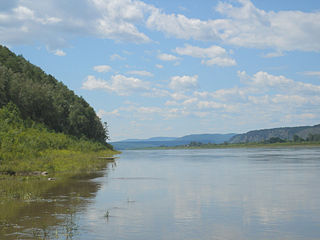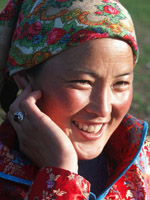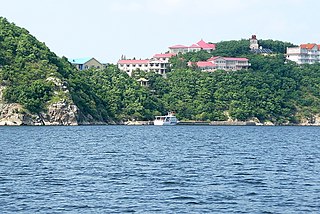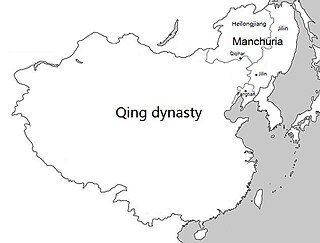
Manchuria is a term that refers to a region in northeast Asia encompassing the entirety of present-day northeast China, and historically parts of the modern-day Russian Far East, often referred to as Outer Manchuria. Its definition may refer to varying geographical extents as follows: in the narrow sense, the area constituted by three Chinese provinces of Heilongjiang, Jilin, and Liaoning but broadly also including the eastern Inner Mongolian prefectures of Hulunbuir, Hinggan, Tongliao, and Chifeng, collectively known as Northeast China; in a broader sense, the area of historical Manchuria includes the aforementioned regions plus the Amur river basin, parts of which were ceded to the Russian Empire by the Manchu-led Qing dynasty during the Amur Annexation of 1858–1860. The parts of Manchuria ceded to Russia are collectively known as Outer Manchuria or Russian Manchuria, which include present-day Amur Oblast, Primorsky Krai, the Jewish Autonomous Oblast, the southern part of Khabarovsk Krai, and the eastern edge of Zabaykalsky Krai.

Khabarovsk is the largest city and the administrative centre of Khabarovsk Krai, Russia, located 30 kilometers (19 mi) from the China–Russia border, at the confluence of the Amur and Ussuri Rivers, about 800 kilometers (500 mi) north of Vladivostok. As of the 2021 Russian census, it had a population of 617,441. It was known as Khabarovka until 1893.

The Amur River or Heilong River is a perennial river in Northeast Asia, forming the natural border between the Russian Far East and Northeast China. The Amur proper is 2,824 km (1,755 mi) long, and has a drainage basin of 1,855,000 km2 (716,000 sq mi). If including its main stem tributary, the Argun, the Amur is 4,444 km (2,761 mi) long, making it the world's tenth longest river.

The Tungusic languages form a language family spoken in Eastern Siberia and Manchuria by Tungusic peoples. Many Tungusic languages are endangered. There are approximately 75,000 native speakers of the dozen living languages of the Tungusic language family. The term "Tungusic" is from an exonym for the Evenk people (Ewenki) used by the Yakuts ("tongus").

The Daur people, Dagur, Daghur or Dahur are a Mongolic people originally native to Dauria and now predominantly located in Northeast China. The Daur form one of the 56 ethnic groups officially recognised in the People's Republic of China. They numbered 131,992 according to the latest census (2010) and most of them live in Morin Dawa Daur Autonomous Banner in Hulun Buir, northeastern Inner Mongolia and Meilisi Daur District in Qiqihar, Heilongjiang, Northeast China. Some Daur people also live near Tacheng in Xinjiang.

The Nanai people are a Tungusic people of East Asia who have traditionally lived along Heilongjiang (Amur), Songhuajiang (Sunggari) and Wusuli River (Ussuri) on the Middle Amur Basin. The ancestors of the Nanai were the Wild Jurchens of northernmost Manchuria.

Aigun was a historic Chinese town in northern Manchuria, situated on the right bank of the Amur River, some 30 kilometres (19 mi) south (downstream) from the central urban area of Heihe.

Blagoveshchensk is a city and the administrative center of Amur Oblast, Russia. It is located at the confluence of the Amur and the Zeya Rivers, opposite to the Chinese city of Heihe. Population: 241,437 (2021 Census); 214,390 (2010 Census); 219,221 (2002 Census); 205,553 (1989 Soviet census).

The Udege are a native people of the Primorsky Krai and Khabarovsk Krai regions in Russia. They live along the tributaries of the Ussuri, Amur, Khungari, and Anyuy Rivers. The Udege speak the Udege language, which belongs to the Tungusic language family. Their religious beliefs include animism, animal worship, and shamanism. The Udege are mainly engaged in hunting, fishing, and ginseng harvesting. According to the 2002 census, there were 1,657 Udege in Russia, a slight increase from 1,500 in 1970. This was down to 1,496 Udege in Russia in the 2010 census. They are one of the closest ethnic groups to the Manchu and Nanai, and are possibly of Xi Yeren Jurchen origin.

Tungusic peoples are an ethnolinguistic group formed by the speakers of Tungusic languages. They are native to Siberia, China, and Mongolia.

The Nanai language is spoken by the Nanai people in Siberia, and to a much smaller extent in China's Heilongjiang province, where it is known as Hezhe. The language has about 1,400 speakers out of 17,000 ethnic Nanai, but most are also fluent in Russian or Chinese, and mostly use one of those languages for communication.

Ning'an is a city located approximately 20 km (12 mi) southwest of Mudanjiang, in the southeast of Heilongjiang province, China, bordering Jilin province to the south. It is located on the Mudanjiang River, which flows north, eventually falling into the Sungari River near Sanxing.
The Heishui Mohe, rendered in English as Blackriver Mohe or Blackwater Mohe, were a tribe of Mohe people in Outer Manchuria along the Amur River in what is now Russia's Khabarovsk Krai, Amur Oblast, Jewish Autonomous Oblast, and Heilongjiang in China.
Dauriya is a historical and geographical region of Russia spanning modern Buryatia, Zabaykalsky Krai and the Amur Region. The toponym is given according to the Daur people who inhabited the region until the middle of the 17th century, about whom it first became known after the expedition of Enalei Bakhteyarov in 1640.

The Sino-Russian border conflicts (1652–1689) were a series of intermittent skirmishes between the Qing dynasty of China, with assistance from the Joseon dynasty of Korea, and the Tsardom of Russia by the Cossacks in which the latter tried and failed to gain the land north of the Amur River with disputes over the Amur region. The hostilities culminated in the Qing siege of the Cossack fort of Albazin in 1686 and resulted in the Treaty of Nerchinsk in 1689 which gave the land to China.
Onufriy Stepanov was a Siberian Cossack and explorer of the Amur River. For background see Russian–Manchu border conflicts.
Šarhūda, known also under the Chinese transcription of his name, Shaerhuda, was an ethnic Manchu military commander during the early Qing dynasty, active both before and after the Qing conquest of China proper.
Boris Petrovich Polevoy, also Polevoi was a Soviet historian known for his work on the history of the Russian Far East. He was honored in Kamchatka for his work on the study of the region's history, and has been described in the West as "a leading Soviet specialist on the history of Russian cartography".
Dular Bombogor was an Evenk chief, leader of the Evenk federation. His power base laid on the basin of the Amur river.

Manchuria under Qing rule was the rule of the Qing dynasty of China over the greater region of Manchuria, including today's Northeast China and Outer Manchuria, although Outer Manchuria was lost to the Russian Empire after the Amur Annexation. The Qing dynasty itself was established by the Manchus, a Tungusic people from Manchuria, who later replaced the Ming dynasty as the ruling dynasty of China. Thus, the region is often seen to have had a special status during the Qing and was not governed as regular provinces until the late Qing dynasty, although the name "Manchuria" itself is an exonym of Japanese origin and was not used by the Qing dynasty in Chinese or Manchu.














